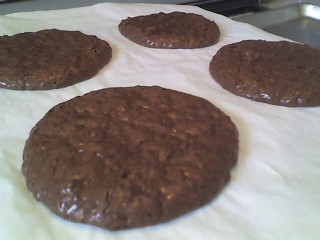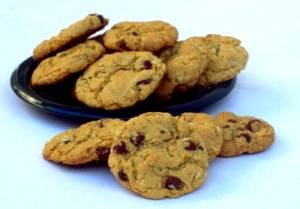I've made the classic French dish
coq au vin a few times recently, from different recipes, and have been struck by the commonalities and variations among the recipes. Coq au vin, at its simplest, is just a chicken, cut up and browned, then simmered with bacon, mushrooms, pearl onions and thyme in red wine. But like any great dish cooked frequently by home cooks across France, and now across the world, it has many variations, some of which add greatness and some of which doubtless just add labor. It's all a matter of taste, of course, so I have no idea what the "best" recipe may be, but you could do worse than to spend your time trying to find it... I've done some brief Internet research on the history of the dish, and have some notes on ingredients, a comparison of six variations, and a very modern footnote.

The "coq" in coq au vin just means rooster, or an old chicken best suited for stewing, not frying. There's a
legend that the recipe originated with Caesar's cook, who when Caesar received from the Gauls an old rooster as tribute after they had been conquered, made the best of it he could. I've made the recipe with a smaller, younger chicken, which generally would have less flavor than an old bird. As always, a free-range chicken would presumably be more flavorful, and one recipe suggests using more flavorful dark meat thighs and drumsticks to imitate some of the richness in taste of a stewing rooster.
The other standard ingredients are pearl onions, mushrooms, red wine, brandy, and chicken stock. One recipe notes that to peel pearl onions, cut an X on the root end, par-boil them for a few minutes, then slip off the skins. This works pretty well... Another recipe suggests just using frozen pearl onions. Plain white mushrooms are traditional, but morels or wild mushrooms certainly wouldn't hurt. For wine, a fruity red such as a pinot noir (Burgandy, if French) or zinfandel is traditional, but a very good recipe reprinted below uses dry vermouth. Not all of the recipes I've seen use chicken stock, but most do, and one even suggests making a quick stock with the back and wings of the chicken. I'm not sure you'll get enough flavor from that to make it worthwhile though.
Here's my
babelfish-aided translation of a
French recipe for coq au vin from 1938:
Coq au Vin (from an old recipe)
Larousse Gastronomique (1938)
Cut into six pieces a young chicken from Limagne. In a casserole pot, add 2 T butter and 4 T lard, then trim and add some small onions. When they are ready, add to the pot the chicken pieces, a small clove of garlic, minced, a bouquet garni, and morels or mushrooms. Brown on high heat, then degrease. Add a finger of good brandy, flambe, then add to every a half liter of wine from Auvergne. After cooking on high heat, remove the chicken, then serve it with the sauce, thickened with beurre manie.
(Limagne is a region of Eastern France, a
bouquet garni is usually a bundle of parsley, thyme, and bay leaves, Auvergne is a wine region of central France that makes light, fruity wines, and
beurre manie is a mixture of flour and butter used to thicken sauces. Note the use of lard -- pork fat -- in lieu of bacon.)
And here are five other recipes, of which I've made the first two. The second one is non-traditional, with
vermouth instead of red wine, but particularly excellent. I've summarized the main components of a coq au vin for each recipe, describing what that recipe uses for each component. It should be easy to see the variations...
Williams-Sonoma Chicken cookbook:
- chicken -- brown with salt and pepper
- bacon -- 1/4 lb pancetta, fried and chopped
- vegetables -- 6 sm shallots, 1/2 lb mushrooms
- herbs -- thyme
- wine -- 2 c Zinfandel, 1/4 c cognac (flambee)
- other -- 1 c chicken stock, 2 t tomato paste
- thicken -- beurre manie
- serve with -- egg noodles
Global Gourmet:
- chicken -- brown with flour, salt and pepper
- bacon -- 4 slices bacon, chopped and fried
- vegetables -- 2 c pearl onions, 1 celery, 1 carrot, 1/2 lb mushrooms
- herbs -- tarragon and tyme, garnish with chives
- wine -- 1 1/2 c dry vermouth
- other -- 1 t sugar
- thicken -- reduce
- serve with -- pasta or potatoes
Nigel Slater (The Observer):
- chicken -- large, brown with salt and pepper, make stock from carcass
- bacon -- 1/4 lb pancetta, thickly chopped and fried
- vegetables -- 2 onions, 1 carrot, 2 celery, 2 garlic, 12 pearl onions
- herbs -- thyme, bay leaves
- wine -- one bottle full-flavored fruity red , 2 T cognac (flambee)
- other -- chicken stock made with carcass, onion, carrot. cook pearl onions and mushrooms separately and add.
- thicken -- 2 T flour, reduce
- serve with -- boiled potatoes
Cooks Illustrated, January 1999:
- chicken -- 3 lbs thighs and drumsticks, brown with salt and pepper
- bacon -- 6 oz thick cut bacon, cubed and fried
- vegetables -- 1 carrot, 1 onion, 2 shallots, 2 garlic, cooked then strained out; 1 lb frozen pearl onions, 1/2 lb mushrooms
- herbs -- bouquet garni, parsley to garnish
- wine -- 1 bottle pinot noir
- other -- 2 1/2 c chicken stock
- thicken -- beurre manie
- serve with -- not specified
Bon Appetit:
- chicken -- 1 large, marinated with wine and vegetables, brown with salt and pepper
- bacon -- 6 oz thick cut, in strips, fried
- vegetables -- 1 onion, 2 celery, 1 carrot, 1 garlic, for marinade; 2 shallots, 2 garlic, cooked then strained out; 1 lb wild mushrooms, 20 pearl onions, cooked separately then added
- herbs -- thyme, parsley
- wine -- 1 bottle Burgandy/pinot noir
- other -- 2 c chicken broth
- thicken -- 3 T flour
- serve with -- not specified
And finally, from The Surreal Gourmet on the Food Network Canada, comes
this recipe for a deconstructed coq au vin. Marinated then baked chicken drumsticks, braised shallots, mushroom pate, roasted bacon, and a small tumbler glass of wine, all served separately and elegantly on a long white plate.

Labels: food
 That last part is important--the cookies are fragile and will stick like glue to a baking sheet, and carefully peeling them off the parchment paper is the only hope of keeping them intact. But it's worth it, as the perfectly circular cookies look like they were made by a pro, even if the picture is taken with a cell-phone camera. And they taste fantastic too; a worthy challenger to oatmeal-chocolate chip cookies. Kudos to Molly at Orangette.
That last part is important--the cookies are fragile and will stick like glue to a baking sheet, and carefully peeling them off the parchment paper is the only hope of keeping them intact. But it's worth it, as the perfectly circular cookies look like they were made by a pro, even if the picture is taken with a cell-phone camera. And they taste fantastic too; a worthy challenger to oatmeal-chocolate chip cookies. Kudos to Molly at Orangette.














